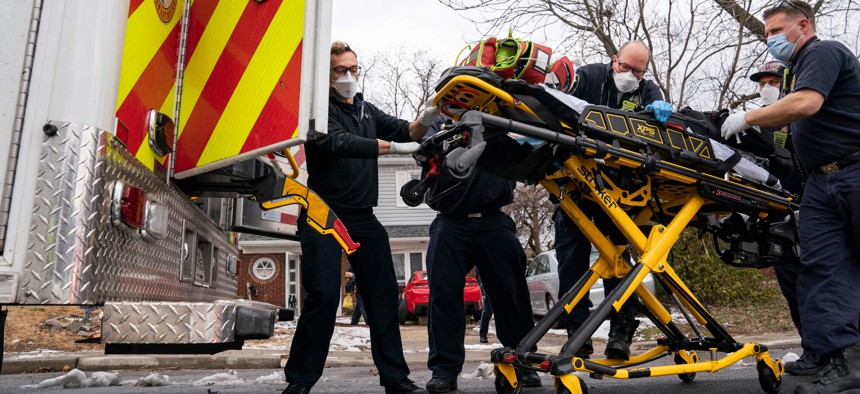Biden Aide Urges Mayors to Direct ARPA Spending Towards Workforce

Firefighters and paramedics with Anne Arundel County Fire Department load a pediatric Covid-19 patient with underlying conditions who is in cardiac arrest into an ambulance after responding to a 911 emergency call on Jan. 17, 2022 in Glen Burnie, Maryland. Photo by ALEX EDELMAN/AFP via Getty Images
Given flexibility in using American Rescue Plan Act dollars, cities are asked to focus on recruiting and retaining essential workers.
As an economic forecast predicted that worker shortages will plague the country for years, the White House coordinator for the American Rescue Plan Act challenged the nation’s mayors Wednesday to use pandemic relief dollars from the law to retain and recruit essential workers.
“Please ask yourself when it comes to increasing our supply of critical workers, what more can you do for your country?” Gene Sperling, special assistant to President Biden, said at the U.S. Conference of Mayors annual winter meeting in Washington.
”Are we doing everything we can with the American Rescue Plan to retain the workers we need?” he said.
The White House will announce a workforce-oriented effort of its own on Thursday, Department of Health and Human Services Secretary Xavier Becerra said at the meeting. He said the Biden administration will make available 40 or 50 grants to “address burnout and promote mental health and wellness" in the health care sector.
“Make sure that your state and your cities are aware of it so you can kind of gain access to some of those funds,” he told the mayors.
The comments from the White House officials come as the nation faces a shortage of nurses, police officers and other essential workers, as less of the workforce is employed or even looking for work amid the pandemic, Jim Diffley, chief U.S. economist at IHS Markit, told the mayors at the meeting.
Diffley offered some positives, saying his firm forecasts the economies of metropolitan areas will grow again this year, 4.6%—a slower rate than last year’s 5.9% but faster than the 4.3% increase in the nation’s economic output as a whole.
That anticipated growth would come after 70% of metropolitan areas saw their economies expand by at least 2% last year after dropping sharply at the start of the pandemic in 2020.
However, Diffley warned of a continuation of what he termed the “great resignation.” He said that 370,000 people quit their jobs in November, leading to an all-time high of 4.5 million resignations last year.
The percentage of the workforce either working or looking for a job dropped to 61.9% in December, compared to 63.4% in January 2020, as more people stay home to avoid the virus and as some are refusing to comply with vaccine requirements at workplaces.
State and local agencies, like other employers, have been dealing with worker shortages, affecting positions ranging from those in public safety fields, to waste haulers, to snowplow drivers. Meanwhile, many health departments have seen historic turnover, with workers pressured by the pandemic.
IHS predicted that the percentage of workforce participation would remain depressed in three-quarters of metropolitan areas this year. Nationally the participation rate would remain roughly at the same lower level through at least 2025, the firm also said.
“The labor rate is well below pre-pandemic, what you’d consider as normal,” Diffley said.
The gathering of mayors comes about two weeks after the Treasury Department issued a final rule that gives localities and states greater flexibility and certainty in how they can spend $350 billion in direct federal aid provided through the American Rescue Plan Act.
Sperling said the Biden administration heard calls from state and local leaders to give their governments “flexibility, flexibility, flexibility” in deciding how to spend the aid.
Miami Mayor Francis Suarez, the conference’s president, also credited the Biden administration for giving cities greater authority in deciding how to spend the money than in the 2020 pandemic relief law known as the CARES Act.
“I think there was a very vast improvement between CARES and ARPA,” he said at a press conference. “We worked very very arduously to make sure that the money went directly to cities and not to counties or states. A lot of it got unfortunately bottlenecked under CARES.”
But “with flexibility comes great responsibility,” Sperling emphasized.
“Are we going the extra mile to get hero retention bonuses to help workers with childcare costs or necessary paid leave for omicron absences?” he said.
“Are we doing everything to meet this moment?" he added. "Are we using American Rescue Plan dollars to hire teachers and an army of tutors to address learning loss? Bus drivers? Are we hiring and creating the expansion of community health care workers?”
Kery Murakami is a senior reporter for Route Fifty and is based in Washington, D.C.
NEXT STORY: Cities and States Find New Ways to Tax Streaming Services






